Implementing Flawless Designs with Accurate I²C Real-Time Clocks
Abstract
This application note presents an overview of the operational characteristics of accurate I²C real-time clocks (RTCs), including the DS3231, DS3231M, and DS3232. It focuses on general application guidelines that facilitate use of device resources for power management, I²C communication circuit configurations, and I²C characteristics relative to device power-up sequences and initializations. Additional discussions on decoupling are provided to support developing strategies for mitigating power-supply pushing of device frequency.
Introduction
Over the years, I²C communications has become a reoccurring theme in customers' questions about accurate real-time clocks (RTCs). This includes basic subjects such as circuit setup and operation, and managing communications to all devices on the I²C port. In many instances, several key decisions need to be made prior to implementing circuit and firmware designs. This application note provides a basic operational overview of the characteristics of the accurate RTC, so hardware/firmware engineers can decide how to effectively manage accurate RTC resources.
Key Operational Characteristics of the I²C Port in Accurate RTCs
Analog's accurate RTCs have dual power supplies. As shown in Figure 1, three power-supply configurations can be implemented, depending on the application and desired use condition. The intent of these supplies is to offer managed, low-current power switching between primary power sources, and backup power sources such as batteries or supercapacitors.
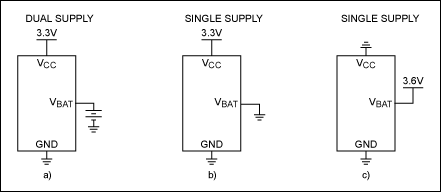
Figure 1. Power-supply configurations.
Unlike many standard RTCs that use dual supply architectures, Analog's RTCs make I²C port communication possible, regardless of which supply is powering the device. This means that a user can communicate with the device when powered from the primary power supply or when the device is powered via the VBAT (or secondary supply terminal). Most dual-supply modes only allow communication with the device when it is powered via the primary supply or VCC.
This feature can complicate the design. Implementing a circuit that communicates regardless of the power supply used requires a careful consideration of how to set up the I²C port. In the absence of a supply, the I²C port needs to be powered and available. SDA and SCL should not be pulled to ground by the absent supply; otherwise communication cannot take place.
The general approach when using two supplies is to use an ORing diode to switch between supplies. Figure 2 illustrates the technique described. The importance of this method is to insure that proper power-supply isolation is achieved when one supply is not available or may be at ground potential.
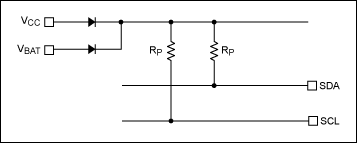
Figure 2. Dual-supply I²C setup.
Figure 3 provides an example of the single-supply modes of operation, which are easily configurable for I²C communications. Pullup resistors are simply tied to the power supply that will be used during communications with the RTC.
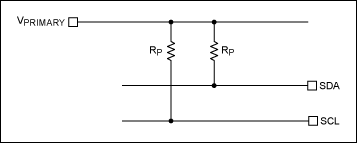
Figure 3. Single-supply I²C setup.
Power-Supply-Dependent Device Initializations
Accurate RTCs will initiate certain actions that depend on which one of the two supplies is connected during an initial application of power. In applications where a battery is used (connected to VBAT), generally the battery voltage will be the first voltage that the RTC will see. To conserve battery power, the RTC has a "freshness seal" mode. This mode prevents internal circuits from powering before the beginning of full operation. This mode is released given that one of two conditions is achieved. First, an RTC will exit "freshness seal" mode when a valid voltage is applied to the VCC terminal. The second condition for exiting "freshness seal" will occur if a valid I²C address is received by the device when operating from a valid VBAT supply voltage.
Once either condition is satisfied, the accurate RTC oscillator will start. The typical oscillator startup time is less than 1 second. Approximately 2 seconds after a valid VCC or valid I²C address, the RTC will make a temperature measurement and apply the calculated correction to the oscillator. At this point, the RTC will continue to run and make adjustments to frequency output as long as a valid power source is available (VCC or VBAT). Temperature measurements will be made at regular intervals (specified by the device type) and calculated corrections will be made based on the oscillator time base—either digital (DS3231M, DS3232M) or analog (capacitive loading: DS3231S, DS3232, DS3234, DS32kHz).
On the first power-up (when an internal power-on reset (POR) sequence is initiated), the time and date registers are set to 01/01/00 01 00:00:00 [DD/MM/YY DOW HH:MM:SS] (where DD = day, MM = month, YY = year, DOW = day of week, HH= hour, MM = minute, SS = seconds).
Communication with the I²C should be held off at least for the first 2 seconds after a valid power source has been established. It is during the first 2 seconds after power is established that the accurate RTC starts its oscillator, recalls calibration codes, initiates a temperature sensor read, and applies a frequency correction.
Attempting to read the device during a power-up can cause undetermined results with regards to timekeeping accuracy, or it may corrupt recalls in calibration memory. For crystal-based RTCs, a corruption in the recall event may result in the need to initiate another temperature conversion/frequency correction.
Most application problems with regards to I²C communication are related to I²C port activity being staged within the first 2 seconds of power being applied or the device receiving a valid I²C address when powered from VBAT. Figure 4 illustrates a preferred timing diagram for safely beginning communication with an accurate RTC. Once the "device operational" region is reached, I²C communication can safely begin without interrupting the POR initialization sequences.
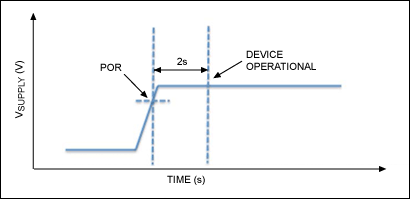
Figure 4. Power-up timing diagram.
Managing Power Supplies in Single-Supply Operation
The three modes of power-supply configurations were briefly introduced in the "Key Operational Characteristics of the I²C Port in Accurate RTCs" section. Although the accurate RTCs are uniquely designed to manage dual-supply modes of operation, some users desire to create custom dual-supply modes of operation external to the RTC. They choose to operate the RTC in a single-supply configuration, either applying power to the VCC terminal or VBAT terminal.
When designing custom external switching of supplies, place careful consideration on I²C communication, power-supply decoupling, and when using a battery to be a power source, consider decoupling requirements as it relates to power consumption. It is important to understand switching characteristics such as noise, ground bounce, and switchover times directly at the accurate RTC. Be aware of the device power-initialization sequences, frequency update rates, and operational characteristics when in a single-supply mode. Each device may have slightly different operational performance, depending on whether it is powered from the VCC or VBAT terminal. Microeletromechanical systems (MEMs)-based RTCs will have different frequency adjustment rates, depending on whether they are powered from VCC (1s) or VBAT (10s).
Data sheet recommendations for decoupling capacitors on VCC are 0.1µF and 1.0µF. These capacitors are to be placed as close to the device as possible. In configurations where the user intends to switch supplies through the use of diodes or to place resistors in series with the power-supply terminals, it is still recommended that decoupling take place as close as possible to the supply terminal of the device. This is true regardless of whether the VCC or VBAT terminal is used as the primary supply. Figure 5 illustrates this position with a series resistor shown.
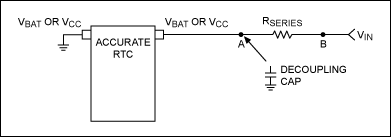
Figure 5. Decoupling of single power supplies.
Managing Power Supplies in Dual-Supply Operation
Dual power-supply operation with the use of a battery (on VBAT) to sustain clock registers and/or nonvolatile device memory can benefit from two basic design approaches. First, the decoupling of the primary supply, VCC, should follow the recommendations presented in the previous section Managing Power Supplies in Single-Supply Operation. Secondly, if the VBAT supply is truly a battery, a decoupling capacitor is not always needed or recommended. Since decoupling capacitors placed across a battery will increase leakage currents, to achieve the smallest current consumption, no decoupling capacitor should be used. This is even more important if communication with the accurate RTC is not intended while the device is operating from the VBAT supply.
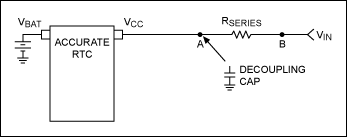
Figure 6. Managing dual power supplies.
Conclusion
Analog's accurate RTC product family offers extremely good timekeeping accuracy in applications where accuracy is paramount. Understanding how a specific device operates from each of the three power-supply configurations will help determine which supply configuration will best fit a particular application. Decoupling of the power supply will always be important to device performance, and following the guidelines outlined will provide the best results.
Always review circuit implementations to understand switching characteristics such as noise, ground bounce, and switchover times at the accurate RTC with the intent of minimizing these switching characteristics. Be aware of the device power-initialization sequences, frequency update rates, and operational characteristics when in a single-supply mode. For all modes of power-up, be mindful of the need for a 2-second delay prior to initiating an I²C communication.